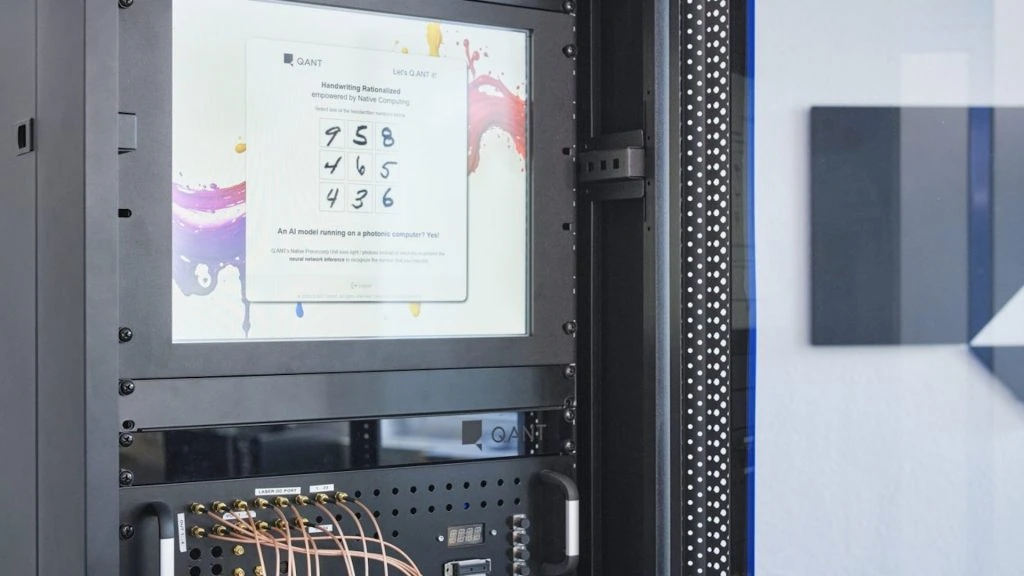Q.ANT’s photonic native computing technology processes data using light instead of electrons. It can therefore handle complex computing tasks more efficiently than today’s chip technologies. The innovative photonic chip technology therefore has the potential to completely change the digital landscape.
Q.ANT, a German startup for light-based computing, is giving researchers and developers the first opportunity to explore photonic computing via cloud access to the company’s Native Processing Unit (NPU). By processing data with light instead of electrons, Q.ANT ‘s photonic native computing technology performs complex computing tasks more efficiently than today’s chip technologies. The innovative photonic chip technology therefore has the potential to completely change the digital landscape. Users can see this for themselves with the help of a web demonstration involving the recognition of handwritten numbers.
With this demonstration, Q.ANT offers an insight into next-generation computing applications for high-performance computing (HPC), physics simulations and artificial intelligence. Interested parties can view the demo on the Q.ANT website at https://native.qant.com/.
Light instead of silicon – energy benefits of the NPU for data processing
The use case demonstrated in the cloud is a representative example of tasks that every data center has to deal with today. The fundamental difference is that, unlike conventional CMOS processors, Q.ANT’s NPUs process data with light. This paradigm shift enables Q.ANT to perform basic mathematical operations in a much more energy-efficient way. For example: While a conventional CMOS processor requires 1,200 transistors to perform a simple 8-bit multiplication, Q.ANT’s NPUs achieve this with a single optical element. For this process alone, the Q.ANT NPU is thirty times more energy efficient than its conventional CMOS counterpart.
“With the growing demand for AI, the need for energy-efficient solutions is also increasing. Q.ANT is leading the way with a working photonic processor – far beyond the research phase that most others are still in,” says Dr. Michael Förtsch, CEO of Q.ANT. “This demonstration is an important step towards reducing AI’s energy requirements and CO2 emissions. We invite researchers and developers to explore the real potential of photonic computing through our hands-on demonstration.”
Chip material as a key element
A key element of this breakthrough is Q.ANT’s proprietary chip material platform based on “Thin-Film Lithium Niobate (TFLN)”. It is the backbone of all Q.ANT NPUs and ensures precise light control at chip level. The start-up has developed this platform since its foundation in 2018 and controls the entire value chain – from the raw material to the finished chip.
Combined with a deep understanding of light, this enables Q.ANT to increase the mathematical and algorithmic density even beyond the density of conventional CMOS processors. An example: While the basic mathematical function of a Fourier transform requires thousands to tens of thousands of complex multiplications, equivalent to millions of transistors, optics achieves this with a single element.
“The key to harnessing the potential of light for data processing lies in the end-to-end control of light. Any compromise drastically reduces the probability of success. That’s why, unlike all our competitors, we at Q.ANT have chosen the deep-tech approach and developed a superior chip platform for light processing,” says Förtsch.
Shifts in the industry
The semiconductor industry is turning to new technologies to meet the growing demand for computing power. This demand for powerful yet energy-efficient technologies is further fueled by the widespread use of AI. In addition to training new large-scale language models, AI inference is a particularly energy-intensive AI application, and Q.ANT’s NPUs are a promising solution.
Gartner describes photonic computing as an emerging computing paradigm that could address performance and energy consumption challenges in AI and data centers, and has identified Q.ANT as a sample vendor in recent Gartner Hype Cycle reports.
Web demonstration proves lower power consumption
In the web demonstration, the user can select an image of a handwritten number from the MNIST (Modified National Institute of Standards and Technology) database. Using a trained neural network, the NPU predicts the number (0-9) and performs an efficient matrix-vector multiplication on the photon chip. With a recognition accuracy of 95 percent, this demonstration proves that Q.ANT’s photonic processor – which is powered by light and based on TFLN technology – can perform complex AI tasks with lower power consumption. This is the first time that such a photonic processor has been successfully used in a practical application. It thus underlines its potential for all AI tasks.
The demonstration of the photonic NPU provides valuable insights into how photonic computing can be used in practice to overcome the current limitations of AI and machine learning, paving the way for future advances in this transformative field.
“We are developing native processors that solve today’s logical problems natively by using light as a medium,” says Förtsch. “Imagine a future in which high-performance computers work with minimal energy consumption and are at least as powerful as our brains – that is the vision behind native computing.”
(sp/Q.ANT)















